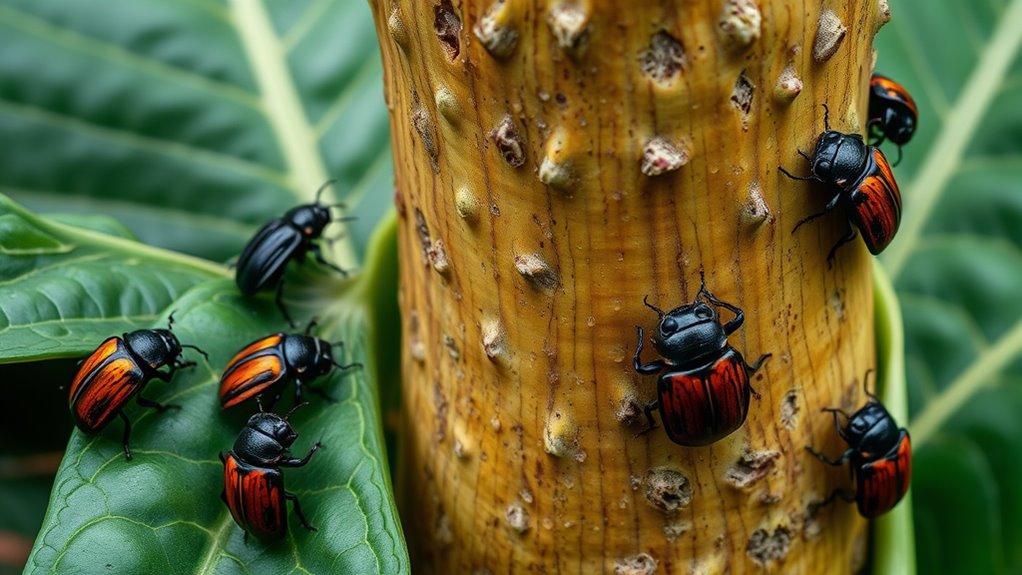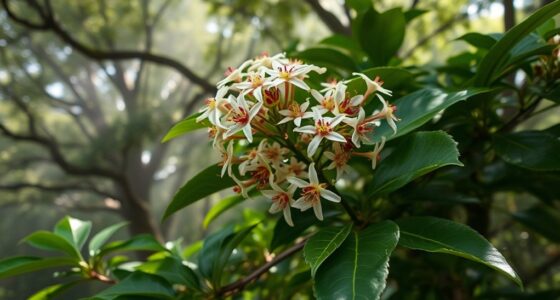When you explore the Titan Arum, you’ll find its foul smell is a clever trick to attract carrion beetles. The plant mimics rotting flesh to lure these insects, which are naturally drawn to decaying material. As the beetles land, they pick up pollen, helping the flower reproduce. This sneaky strategy shows how the plant uses deception for survival—if you’re curious, there’s more to uncover about this fascinating plant’s tactics.
Key Takeaways
- Titan Arum emits a strong, decaying flesh smell to attract carrion beetles for pollination.
- The foul odor mimics dead flesh, enticing beetles seeking a food source and breeding site.
- Carrion beetles are drawn to the thermal warmth and scent, guiding them to the flower’s central chamber.
- The plant benefits from beetles transferring pollen between flowers, ensuring reproductive success.
- The smell functions as an evolved strategy, leveraging insect behavior to facilitate pollination despite human aversion.

The Titan Arum, also known as the corpse flower, attracts carrion beetles with its foul smell, mimicking decaying flesh to lure pollinators. When you’re nearby, you’ll notice the strong, unpleasant odor that seems to fill the air around it. This smell isn’t accidental; it’s a carefully evolved strategy that the plant uses to attract specific pollinators—carrion beetles and flesh flies—that are drawn to dead animals. As you observe the flower, you realize that its scent acts like a magnet, guiding these insects to the bloom’s central chamber. Once inside, the beetles and flies are enticed by the warmth and the promise of food, which, in this case, is the decaying flesh-like smell.
You might wonder why a plant would want to mimic such a repulsive smell. The answer lies in its reproductive process. The Titan Arum relies heavily on these insects for pollination, and by producing a smell that mimics carrion, it effectively tricks the beetles into thinking they’ve found a dead animal. When the beetles land on the flower, they pick up pollen, which sticks to their bodies. Later, as they move on to another flower, they transfer that pollen, helping the plant reproduce. This process is essential for the Titan Arum, which often grows in dense tropical forests where other pollination methods might be less reliable.
As you watch this interaction unfold, you see that the smell is just one part of a complex reproductive strategy. The flower also produces a visual display—sometimes a dark, fleshy appearance—that further convinces insects they’re dealing with carrion. During the bloom’s brief but intense flowering period, the plant’s temperature rises slightly, mimicking the warmth of decaying flesh, which further attracts and retains the pollinators. This thermal mimicry enhances the flower’s ability to lure insects, ensuring that despite its foul odor, pollination occurs efficiently.
You learn that this relationship is a fascinating example of mutualism—both the plant and the beetles benefit. The Titan Arum gets its pollen spread, while the beetles find a food source in the scent and warmth. This smell, which might seem revolting to us, is actually a highly effective and evolved way for the plant to guarantee its survival. So, in the world of the Titan Arum and carrion beetles, what smells bad to humans becomes an essential tool for reproduction, a bizarre yet brilliant example of nature’s ingenuity. Understanding the pollination strategy of the Titan Arum reveals how plants have evolved to utilize even the most unpleasant traits for survival.
Frequently Asked Questions
How Long Does the Smell of Titan Arum Last?
The smell of a Titan Arum typically lasts between 24 to 48 hours, depending on environmental conditions. You might notice it intensifies just before the bloom fully opens and then gradually diminishes as the flower dies back. To enjoy the smell longer, keep the plant in a warm, humid space with good airflow. Be prepared for a powerful, foul odor that can be quite overwhelming during this short-lived event.
Are Carrion Beetles Attracted to Other Plants?
Yes, carrion beetles are attracted to other plants that emit strong, decaying odors, not just the Titan Arum. They’re drawn to a variety of decaying organic matter, including dead animals and decomposing plant material. When you see them around certain flowers or rotting matter, it’s because those sources mimic the smell of carrion, which they naturally seek out for food or breeding sites.
Can Humans Safely Handle the Titan Arum?
You can safely handle the titan arum, but you should do so with care. It’s a large, impressive plant that’s generally harmless, but its enormous size and sharp-edged leaves can cause minor injuries if you’re not cautious. Always wash your hands afterward and avoid touching the flower’s stamen or pistil to prevent irritation. If you’re unsure, it’s best to handle it with gloves or seek guidance from a knowledgeable botanist.
How Do Carrion Beetles Locate Decaying Matter?
You can think of carrion beetles as expert scent detectives; they locate decaying matter through specialized olfactory receptors that detect the strong, foul smell of decomposing flesh. These beetles are highly sensitive to specific volatile organic compounds released during decay, which guide them directly to their food source. Their keen sense of smell is essential for survival, helping them find carrion quickly and efficiently, even over long distances.
Are There Any Other Plants That Mimic Decaying Flesh?
Yes, you find other plants mimicking decaying flesh, like the corpse flower’s relatives in the Araceae family. These plants evolved to attract pollinators by emitting foul odors, tricking insects into believing there’s decaying matter nearby. This mimicry is a survival strategy, helping them reproduce. You might also notice some orchids and certain species of the Stapelia genus, which produce similar smells to lure pollinators effectively.
Conclusion
As you stand witness to this botanical drama, the titan arum’s pungent perfume acts like a siren’s call to carrion beetles, turning decay into a dance of mutual benefit. Together, they orchestrate a symphony of survival, where smell becomes both lure and life force. In this fragrant battlefield, nature’s ingenuity shines brightest—proving that even the foulest scents can forge the most remarkable partnerships, transforming rot into resilience.











